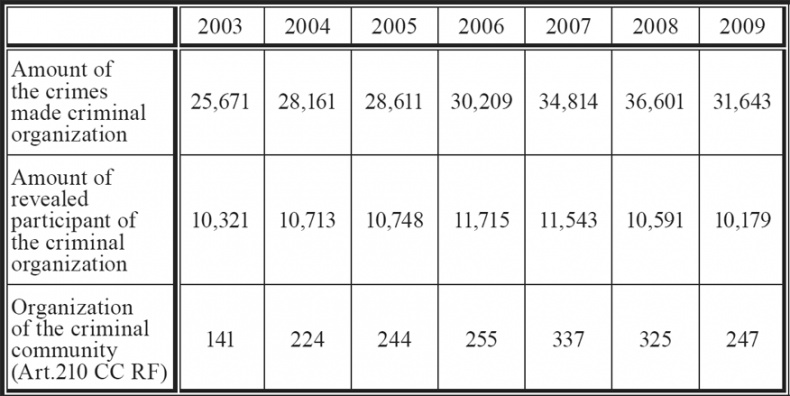Criminal business arises, exists and develops under certain conditions:
• demand for illegal goods (drugs, arms, etc.) and services (sexual, etc.);
• unsatisfied demand for legal goods and services (for example, total «deficit» in USSR);
• unemployment and others sources of social exclusion as social base of deviance, including criminality (Finer & Nellis, 1998; Kanfler, 1965; Lenoir, 1974; Paugam, 1996; Young, 1999);
• defective of tax-policy, customs policy of state, etc.
A criminal organization (syndicate) building up a system of organized crime (industry) is defined by the following key characteristics:
• a stable association of people, designed for long-term activity;
• criminal nature of the activity (financial pursuits dependent on criminal activity);
• deriving maximum profits as the key goal of the activity;
• complex hierarchical structure of the organization with its functions delimitated;
• the corruption of political bodies and law-enforcement bodies as the main means of the criminal activity;
• aspiration to monopolizing a certain type of trade or on a certain territory. The high degree of adaptability of criminal associations (resulting from their strict labor discipline, their careful selection of staff, the high profits, etc.) ensures their great vital capacity («the Mafia is immortal!»). For example, Russian criminal organizations recruit only the youngest, bravest and the most enterprising people.
We can see the trend of the official data about organized crime in Russia (Table 3).
Table 3. Date for crime of criminal organization (2003-2009) (http://www.mvd.ru/stats/)

We can see such main trends: the increase of some factors of organized crime before 2008 and the reduction in 2008, 2009, which has continued also in 2010.
Certainly, we can not completely rely on the official statistics. However, the changes observed in these indicators in Russia as well as in other countries may be indicative of a quantitative reduction of all parameters of criminality during a period of economic and financial crisis. This requires the special studies. But greatly qualitative features of organized crime have also changed greatly.
The following short summary of the history of Russian organized crime can help to understand the contemporary situation (Gilinskiy, 1997; Gilinskiy, 1998; Gilinskiy, 2002; Gilinskiy, 2006, Gilinskiy & Kostjukovsky, 2004). There are several periods of Russian organized crime.
1. Late 1970-s – early 1980-s
Firstly, late 1970s – early 1980s. It is the period when organized criminality in USSR began. This was mostly small illegal business with legal «co-operative societies», as well as big illegal business under the protection and with the participation of the leader communist party and state authorities, illegal exchange of currency and speculation («farcovka»). Scandals involving the illegal manufacturing and sale of cotton, fruit, caviar and fish in the 1970s and 1980s revealed for the first time the close alliances that «tenevics» (shady dealers) and other «traditional» criminals had with executive staff and official leaders of the Soviet Republics (the first secretaries of the Central Committees of the Communist Party in Uzbekistan, Azerbaijan, Moldova, Georgia, Kazakhstan were all at some point involved in scandals), the central bodies of Communist Party, as well as government and law enforcement bodies.
2. Late 1980s – mid 1990s
Secondly late 80s until mid 90s was a period of the formation and shaping of the «persisting» organized crime. For instance, in 1990s in St. Petersburg there were four criminal communities of the mafia type (so-called Tambov's, Azerbaijan's, Chechen's, and Kazan's), some dozens of criminal associations (for example, Komarov's), and hundreds of criminal groups.
These were larger criminal organizations, concerning with racket, drug trafficking, the «protection» (racket) of small and middle-sized business, market trade, sex-business, theft and selling of cars, smuggling of non-ferrous metals across the border (through Estonia), control over gambling, production of and trafficking counterfeit hard liquor. Couterfeiting strong alcoholic drinks is a traditional criminal business. In 1990s it become possible to join with the legal strong drinks production. International brands such as vodka «Absolut», «French» cognac «Napoleon», «Italian» liquor «Ama-retto», and other appeared in commercial centres in large amounts. They were produced… in the city and in the area around it. The result of the international cooperation of criminals was that greater amounts of become that greater amount of adulterated strong drinks was produced, but afterwards counterfeited strong drinks were produced. But afterwards the authentic goods (atn corresponding prices) were on sale in Russia. These were imported from Poland, Hungary, Holland, and Germany.
The Center of Deviantology (Sociology of Deviance) of the Sociological Institute of the Russian Academy of Sciences has been involved in a criminological study into the black market, economy and organized crime since 1993. Business in St. Petersburg and other regions of Russia was divided among the criminal communities. Highly organized informational services enable them to track and monitor all the commercial structures, and the moment when a new commercial structure begins making a profit, it arouses the interest of criminal groups. As one businessman interviewed asserted: «100 % of commercial structures are embraced by racket… Racketeering penetrates all the enterprises except those of military-industrial complexes and some foreign firms». One officer of FSB (Federal Service Security) told me: «Criminal associations control about 90 % business».
There were two levels of racketeering: tribute money extracted from small kiosks and shops («black racket») and that obtained from commercial enterprises. In the latter case one can distinguish various indirect, disguised types of racket: payments for «guarding», for «service in the field of marketing» in compliance with the contract for «cooperation», or for «services» (for example, recovering debts). The «taking care» by the criminal organizations of commercial structures includes having their representatives on the administrative and managerial bodies.
Based on the information from our respondents, we are in a position to identify the typical situations where businessmen are forced to commit crimes.
One has to bribe in the following situations: when registering business; when renting premises from state bodies; when acquiring licenses for their utilization from state bodies; for obtaining low-interest bank credit; when reporting to tax inspectors; when completing customs formalities; etc.



